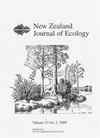足迹跟踪和陷阱捕获用于探测皮肤的比较
IF 1.4
3区 环境科学与生态学
Q3 ECOLOGY
引用次数: 3
摘要
:生物多样性的清查和监测需要有效的采样工具。新西兰开发的足迹追踪隧道用于监测小型哺乳动物,也可能有助于对蜥蜴和其他爬行动物进行采样,但还需要更多的研究来验证这一点。为此,我们使用两种方法比较了陆地石龙子的可探测性:陷阱捕获和足迹跟踪。在新西兰,前者是对皮肤进行采样的传统方法,而后者通常用于监测引入的啮齿动物和鼬的种群。2019年1月,我们在南岛南部的蒂瓦伊半岛上运行了包含5×5个陷阱阵列和标准啮齿动物追踪隧道的成对网格,并比较了陷阱和隧道的每日比例,这些陷阱和隧道分别通过捕获和脚印检测到石皮。总的来说,追踪隧道探测到skinks的可能性大约是陷阱的两倍。需要进行额外的研究:(1)测试足迹跟踪与传统检测方法对其他蜥蜴和爬行动物物种的相对有效性;(2) 研究替代隧道设计和长寿命诱饵;以及(3)根据密度估计值校准足迹跟踪率,以评估监测的适用性。本文章由计算机程序翻译,如有差异,请以英文原文为准。
Comparison of footprint tracking and pitfall trapping for detecting skinks
: Inventory and monitoring of biodiversity requires effective sampling tools. Footprint tracking tunnels, developed in New Zealand to monitor small mammals, may also be useful for sampling lizards and other reptiles but more research is needed to verify this. To that end, we compared the detectability of terrestrial skinks using two methods: pitfall trapping and footprint tracking. In New Zealand, the former is the traditional method for sampling skinks, while the latter is routinely used to monitor populations of introduced rodents and mustelids. In January 2019, we operated paired grids containing 5 × 5 arrays of pitfall traps and standard rodent tracking tunnels on Tiwai Peninsula in Southland, South Island, and compared the daily proportions of traps and tunnels that detected skinks via captures and footprints, respectively. Overall, tracking tunnels were approximately twice as likely to detect skinks as pitfall traps. Additional research is required to: (1) test the relative efficacy of footprint tracking versus conventional detection methods on other lizard and reptile species; (2) investigate alternative tunnel designs and long-life lures; and, (3) calibrate footprint tracking rates against density estimates to assess suitability for monitoring.
求助全文
通过发布文献求助,成功后即可免费获取论文全文。
去求助
来源期刊

New Zealand Journal of Ecology
环境科学-生态学
CiteScore
3.00
自引率
12.50%
发文量
35
审稿时长
>36 weeks
期刊介绍:
The New Zealand Journal of Ecology is a biannual peer-reviewed journal publishing ecological research relevant to New Zealand/Aotearoa and the South Pacific. It has been published since 1952 (as a 1952 issue of New Zealand Science Review and as the Proceedings of the New Zealand Ecological Society until 1977). The Journal is published by the New Zealand Ecological Society (Inc.), and is covered by Current Contents/Agriculture, Biology and Environmental Science, GEOBASE, and Geo Abstracts.
 求助内容:
求助内容: 应助结果提醒方式:
应助结果提醒方式:


